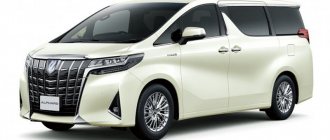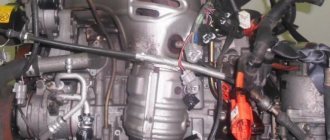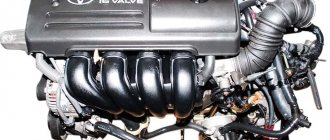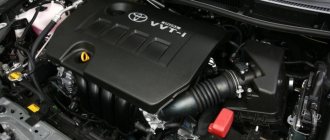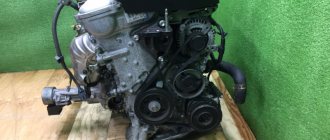Created in the late 90s of the 20th century, the NZ family of engines from the Toyota manufacturer received an alloy block, a plastic intake manifold and a timing chain drive. Within this family, the 1NZ FE engine received the maximum operating parameters - torque of 141 Nm at medium speed and power of 108 hp. With. with a compression ratio of 10.5 units.
ICE 1NZ FE
Initially, a prototype internal combustion engine was tested in the 1NZ-FXE hybrid engine, only after which it entered production. During the period 2000 - 2006, the motor received 10 international awards and was recognized as the most technologically advanced, environmentally friendly and economical power drive in the world.
The developers of the Toyota concern took as a basis a standard engine design - 4 in-line cylinders, made of cast iron wet liners inside an aluminum block. The intake manifold in the engine is plastic, that is, it does not have casting defects or rough surfaces.
Most 1NZ FE models feature VVTi variable valve timing, but only on the intake camshaft. At first, the valve lift height was adjusted by mechanical pushers. In 2004, modernization was carried out, hydraulic compensators appeared, now users do not need to adjust the thermal valve clearances at a service station every 30,000 km.
1NZ FE design
Initially, the series had small volumes of combustion chambers and was intended for light class Toyota cars. The basic version has only 108 liters. pp., it will not be possible to significantly increase power.
Similar design solutions made it possible to obtain the technical characteristics of 1NZ FE:
| Manufacturer | Kamigo Plant |
| Engine brand | 1NZ FE |
| Years of production | 1997 – … |
| Volume | 1497 cm3 (1.5 l) |
| Power | 79.4 kW (108 hp) |
| Torque moment | 141 Nm (at 4200 rpm) |
| Weight | 112 kg |
| Compression ratio | 10,5 |
| Nutrition | injector |
| Motor type | in-line petrol |
| Ignition | DIS-4 |
| Number of cylinders | 4 |
| Location of the first cylinder | TVE |
| Number of valves on each cylinder | 4 |
| Cylinder head material | aluminum alloy |
| Intake manifold | plastic |
| An exhaust manifold | steel welded |
| Camshaft | original cam profile |
| Cylinder block material | Aluminium alloy |
| Cylinder diameter | 75 mm |
| Pistons | with LFA coating |
| Crankshaft | forged steel 4 counterweights |
| Piston stroke | 84.7 mm |
| Fuel | AI-95 |
| Environmental standards | Euro 5 |
| Fuel consumption | highway – 6.6 l/100 km combined cycle 9.5 l/100 km city – 13 l/100 km |
| Oil consumption | 0.2 – 0.4 l/1000 km |
| What kind of oil to pour into the engine by viscosity | 5W30, 10W30 |
| Which engine oil is best by manufacturer | Liqui Moly, LukOil, Rosneft |
| Oil for 1NZ FE by composition | synthetic in winter, semi-synthetic in summer |
| Engine oil volume | 3.7 l |
| Operating temperature | 90° |
| ICE resource | declared 150,000 km actual 250,000 km |
| Adjustment of valves | pushers |
| Cooling system | forced, antifreeze |
| Coolant volume | 5.7 l |
| water pump | Aisin WPT-063 |
| Spark plugs for 1NZ FE | BKR5EYA-11 from NGK or Denso K16R-U11 |
| Spark plug gap | 1.1 mm |
| Valve train chain | 13506-21020 |
| Cylinder operating order | 1-3-4-2 |
| Air filter | AMC TA-1678, Nipparts J1322102, Stellox 7101052SX, Miles AFAD094 |
| Oil filter | Mann W68/3, VIC C-110, C-113, DC-01 |
| Flywheel | 32101-52020, lightweight, 6 bolt holes |
| Flywheel mounting bolts | M12x1.25 mm, length 26 mm |
| Valve stem seals | manufacturer Goetze, inlet light, exhaust dark |
| Compression | from 13 bar, difference in adjacent cylinders maximum 1 bar |
| XX speed | 750 – 800 min-1 |
| Tightening force of threaded connections | spark plug – 25 Nm flywheel – 108 Nm clutch bolt – 64 Nm bearing cap – 22 Nm + 90° (main) and 15 Nm + 90° (rod) cylinder head – four stages 29 Nm, 69 Nm + 90° + 90° |
The engine characteristics are adjusted solely to ensure Euro-4 regulations and the current legislation of the countries to which Toyota cars are planned to be exported.
Design Features
The NZ series turned out to be long-lasting:
- 2000 – 2005 – 105 l. s., 138 Nm, assigned index NZE124;
- 2005 – 2007 – 109 liters. s., 141 Nm, NCP90 index;
- 2007 – 2013 – 110 l. s., 140 Nm, index NZT260;
- 2013 – … – 109 liters. s., 136 Nm, index NZT.
The 1NZ FE naturally aspirated in-line petrol engine includes design features of the ZZ/AZ family and fresh developments from Toyota designers:
- cast iron liners are poured directly into the aluminum block, so overhaul of the cylinders is impossible;
- the cast crankcase serves as an oil pan and ensures block rigidity;
- the axis of the forged steel crankshaft is offset relative to the cylinders by 12 mm;
- lightweight piston skirt with polymer coating, press-fit pins;
- a feature of the intake camshaft is the presence of a VVTi clutch for adjusting valve timing;
- the cylinder head is equipped with standard mounting holes for injectors and valve seats;
- the oil pump is located in the crankcase and has a separate drive from the crankshaft;
- heated throttle valve, “cold” thermostat 84 degrees, mechanical type;
- the pump is driven by a common belt, like all other attachments;
- Double-shaft timing belt, DOHC 16V type, driven by a single-row chain on the exhaust camshaft;
- the manifolds have changed location - inlet at the front, exhaust at the rear, so do-it-yourself boosting was made easier by the designers from the very beginning;
- there is no return line in the fuel system, fine-dispersion multipoint injectors;
- mechanical throttle valve, DIS-4 ignition with separate coils for each spark plug.
Crankshaft axis offset
Gas distribution mechanism
Lubrication scheme
The performance of hydraulic compensators and the VVTi clutch depends on the quality of the oil. The manual contains a detailed description of the maintenance and repair operations of the power drive.
Engine tuning options
We understand VAZ engines
It is theoretically possible to boost the 1NZ FE engine in seven stages:
- exhaust modernization - forward flow, “spider” and ECU correction to produce 145 hp. With. maximum;
- modification of the fuel system - the use of high-performance injectors and Apexi Power FC “brains” to provide 150 hp. With.;
- supercharging - turbine plus intercooling, installation of a high-performance brake system, power increases to 180 - 200 hp. With.;
- supercharger - usually Supercharger
Tuning 1NZ-FE
Thus, the 1NZ FE engine is distinguished by an aluminum block and a timing chain drive according to the DOHC 16V scheme. It is used in almost the entire model range of the Toyota manufacturer, which came off the assembly line from 1997 to 2005, and in some modern cars.
List of internal combustion engine modifications
The 1NZ FXE version arose during the development of the main 1NZ FE engine, became part of a hybrid engine (ICE plus electric) for the Toyota Prius, and has the following characteristics:
- compression ratio 13 - 13.4 units;
- power 74 – 76 l. With.
Hybrid engine 1NZ FXE
Instead of the Otto cycle, the Atkinson method is used here. At low speeds, the wheels of the car are rotated by an electric motor; on large internal combustion engines, from which the battery is charged at the same time. Complex and varied attachments are used, which are not available in the basic version.
Engine tuning
The increase in power is of particular interest to owners of cars with a small engine capacity.
For NZ series motors it is also possible to increase power by installing a centrifugal compressor. This system is an attachment, and its use does not require registration with the traffic police. There are various modifications of charger kits that can significantly increase engine performance. They can have a disconnectable clutch or be fully integrated into the operation of the internal combustion engine. Although this method does not reach full boost, it allows you to increase power to 145 hp. With.
Advantages and disadvantages
Initially, Toyota management included a disposable cylinder block in the power drive, the overhaul of which is impossible. The piston pins cause trouble because they are pressed rather than floating. When a chain breaks or jumps several links after stretching, pistons without counterbore bend the valves when they encounter them.
The advantages of the 1NZ-FE motor are:
- high service life from 300,000 km;
- independent chip tuning to increase power;
- lack of adjustment of valve thermal clearances after 2004.
Cooling system
The power drive uses budget AI-92 fuel economically and is not difficult to maintain and repair.
Characteristics 1NZ
Toyota 4a engine and its modifications for the fourth generation Toyota Celica T160 (1985–89)
The 1NZ-FE gasoline engine, consisting of 4 cylinders with cast iron liners, began production in 2000. Years of production of the NZ series are from 1997 to the present. The block material is aluminum alloy. The motor has the following technical characteristics:
- exact volume – 1497 cubic meters. cm (1.5 l);
- power – 109 hp at 6000 rpm;
- torque – 141 N*m at 4200 rpm;
- compression ratio – 10.5;
- engine weight – 112 kg;
- engine operating temperature – 90°C;
- Oil consumption allowed by the manufacturer is up to 1000 g. per 1000 km;
- oil (quantity and what kind) – 3.7 l, original Toyota Genuine Motor Oil (5W-30, 10W-30)
- engine life is in practice approximately 200 thousand km (depending on operating conditions and regular maintenance).
You can see it in the diagram. How is a cast iron sleeve placed in an aluminum block 1NZ
Fuel consumption
Almost all structural elements of a modern car affect fuel consumption. Cars from the Japanese company Toyota with the 1NZ internal combustion engine are no exception here. For example, a three-door Toyota Yaris with 1NZ-FE and 5-speed manual transmission shows 6.9 liters in the combined cycle per 100 km. Toyota Yaris XP130 with a 5-speed automatic transmission shows a result of 8.8 liters. The consumption of the Toyota Corolla Fielder E160 station wagon with manual transmission is 5.7 liters.
Toyota Yaris and Probox
Which Toyotas was it installed on?
The 1NZ engine was installed on conventional cars, as well as on those belonging to the hybrid series. A later version of the internal combustion engine (marked 1NZ-FE) was installed on the following Toyota models:
- Allex (2001–2006);
- Allion (2001–present);
- Auris (2006–2018);
- bB (2000–2005);
- Corolla (2000–2006);
- Corolla Axio (2006–present);
- Corolla Fielder (2000–present);
- Corolla Rumion (2007–2015);
- Corolla Runx (2001–2006);
- Corolla Spacio (2001–2007);
- Echo coupe and sedan (1999–2002);
- Funcargo (1999–2005);
Toyota Corolla Fielder and Toyota Corolla Rumion
- ist (2002–2016);
- Platz (1999–2005);
- Porte (2004–present);
- Premio (2001–present);
- Probox (2002–present);
- Ractis (2005–2016);
- Raum (2003–2011);
- Sienta (2003–present);
- Spade (2012–present);
- Succeed (2002–present);
- Vitz (1999–present);
- WiLL Cypha (2002–2005);
- WiLL VS (2001–2004);
- Yaris US (hatchback 2005–2017, sedan 2006–2011), Europe (1999–2005)
The 1NZ-FXE engine was installed on the following Toyota hybrids:
Hybrids Toyota Prius and Toyota Sienta
- Aqua (2011–present);
- Corolla Axio (2012–present);
- Corolla Fielder (2012–present);
- Prius Japan (1997–2011), Europe (2000–2009), USA (2000–2009);
- Prius C (2012–2016);
- Probox (2014–present);
- Sienta (2015–present);
- Succeed (2014–present);
- Vitz (2017–present);
- Yaris (2010–2014).
List of car models in which it was installed
The naturally aspirated in-line four-cylinder engine 1NZ FE, operating on the classic Otto cycle, was installed on Toyota modifications:
- Corolla Fielder/Axio – station wagon for Russia and 11th generation sedan;
- Ractis – subcompact van with a glass roof;
- Succeed – right-hand drive minivan with all-wheel/front-wheel drive;
- Probox – family minivan;
- Will – a youth car with an original design;
- Sienta – minivan with sliding doors;
- Allion – a sedan with a sporty exterior;
- Premio – a sedan for the older generation;
- Fun Cargo – a compact van with an original exterior;
- Auris – family hatchback, new generation of Corolla;
- Platz – classic sedan;
- Porte – subcompact van with doors of different types of opening;
- Raum – subcompact van with automatic transmission;
- Vios – sedan;
- bB – subcompact van in English style;
- Yaris/Echo is a classic sedan.
Toyota Fun Cargo
Additionally, these engines were installed in the Scion xB and xA/ist, and the initial version was used exclusively in the Toyota Prius.
Application
The motors are intended for installation on Toyota front-wheel drive vehicles. Since the volume and power of the power plant do not allow its use on large machines, its application is limited to the small class.
Toyota Yaris:
What cars can the engine be installed on:
| Vehicle make | Car names |
| Toyota | Corolla Yaris Premio Belta Raum Platz Fun Cargo Sienta Vill VS Vill VC |
| Gili | SK MK |
| Great Wall | C10 |
| Scion | xA xB |
Maintenance schedule 1NZ FE 1.5 l/108 l. With.
The factory manual indicates maintenance periods and replacement operations for consumables that the 1NZ FE engine has in its design:
- the manufacturer provides for replacement of the roller-type timing chain after 120 - 150 thousand mileage;
- the manufacturer recommends changing oil that has lost its properties after 7,500 km, and antifreeze after 20,000 km;
- It is recommended to change the air and fuel filters after 10,000 and 30,000 mileage, respectively;
- adjustment of thermal clearances of engine valves is carried out once every 2 years (mileage 30,000 km);
- the service life of spark plugs in the DIS-2 system is 30,000 km, when using iridium modifications 60,000 km;
- the exhaust tubular manifold begins to burn out after 50 - 70 thousand mileage.
Replacing the timing chain
Periodically, carbon deposits deposit on the valves and pistons, the crankcase ventilation becomes clogged, and the throttle valve becomes clogged. The above systems need to be flushed and purged and sensors replaced.
Measures to eliminate identified defects
To stabilize the engine speed at idle, you need to thoroughly clean and rinse the throttle body and idle air valve, replace the idle speed controller, air sensor, etc.
An increase in engine oil consumption occurs due to long runs of 150,000 km. In this case, the engine needs to replace the obstructed rings and valve stem seals.
When replacing the single row timing chain and alternator belt, all noise effects disappear. When installing the chain, it must be properly tightened. When changing the chain, it is also necessary to replace the VVT sprocket, tensioner and guide. The chain is lubricated with machine lubricant. To make the motor make less noise, the design provides for the installation of a special tensioner, shoe and chain guide.
To eliminate vibrations of the power unit, you should strengthen the front engine mount, clean the injectors, replace the fuel filter, oil pressure sensor, and rear crankshaft seal.
The tightening torque of the bolts when securing the cylinder head must be equal to the recommended values specified in the technical documentation. All bolts must be tightened strictly according to the instructions. After carrying out these activities, the motor will be firmly fixed.
To the question of what kind of oil to pour, the answer is unequivocal - it is necessary to fill only high-quality motor lubricant into the tank of the power unit in accordance with the manufacturer’s recommendations located in the accompanying documentation of the car. It is recommended to fill the 1nzfe engine with 0W20 engine oil.
Car owners often ask what spark plugs are in the ignition system of 1nz fe power units. According to the vehicle documentation, the 1NZFE engine is equipped with an ignition system that uses spark plugs made of iridium.
Major repairs of the 1NZ engine are not carried out, since the cylinder block installed in it is not repairable after a mileage of over 200 thousand kilometers. Judging by the reviews of car owners, a worn-out engine should not be repaired, but completely replaced with a new copy, because replacing components and components that have failed will cost more than the cost of a new power unit.
At the request of the car owner, it is possible to tune the 1NZ engine; for this it is proposed to use standard tuning kits available for free sale.
Review of faults and methods for repairing them
Due to its design features, the 1NZ FE motor is guaranteed to bend the valve during a timing chain break. However, other faults are more relevant to the user:
| Uncontrolled engine oil consumption | 1) worn valve stem seals 2) coked or worn-out rings | 1) replacing caps 2) replacing rings |
| Third party sounds | 1) chain stretch 2) wear of liners 3) carbon deposits on the valves 4) development of rollers/pushers | 1) replacing the chain with a kit 2) overhaul of the block 3) decarbonization with special detergents 4) replacement of rollers, pushers |
| Floating speed | 1) IAC breakdown 2) damper clogged | 1) replacing the XX regulator 2) cleaning the throttle |
Repair 1NZ FE
All attachments are driven by one belt, so a whistle often occurs, indicating slippage or, conversely, too much tension. Weak points are also the crankshaft rear oil seal and the oil pressure sensor.
What problems might you encounter?
The 2NZ-FE is largely copied from the old 1NZ model. To achieve an engine rating of 1.3 liters, the developers had to modify the design - reduce the stroke, change the crankshaft, and also use a corresponding cylinder block for the small knee.
In general, experts believe that the engines are not very different, because they have the same problems. Owners will have to replace certain components, because everyone will encounter knocking, floating speed, breakdown of the fuel sensor, low engine life, general disposability and much more. Like any other unit it has its pros and cons. Whether it is worth purchasing, everyone will decide for themselves, assessing all the pros and cons. Much depends on the chosen car - if it’s a Toyota Corolla, then it’s a weak option, but if it’s a Yaris, then it’s just right.
1NZ and 2NZ have a large list of similarities. Accordingly, their tuning is monotonous - installation of a compressor and turbine. Due to the fact that the volume of 2NZ-FE is smaller, the result will be lower - by 20%.
Description
The NZ engine series refers to small-volume engines, the use of which is designed for small-class cars. The line includes: a unit marked 1NZ, with a volume of one and a half liters, and an engine 2 NZ FE, with a volume of 1.3 liters. The design of power plants of this type provides for the use of four volumetric displacement chambers located in a row. The material of the motor frame is aluminum alloy; the liners have thin walls made of cast iron with open cooling. A tight connection with the block is ensured by notches and irregularities applied to the surface. The engine is located transversely on the vehicle and is used on vehicles with front-wheel drive.
The gas distribution mechanism is equipped with two camshafts, and there are four valves on each cylinder. The drive is carried out via a chain, and the engine is equipped with a variable valve timing system (VVT-i). Fuel injection occurs sequentially, the injectors have a separate drive and are controlled using an electronic unit that controls the opening and closing moments. Despite the use of advanced technologies, the mechanism is characterized by high fuel consumption; the 1 NZ FE engine consumes 13 liters of gasoline in the urban cycle.
Toyota 1NZ-FE engine:
Ignition of the unit involves installing a coil on each cylinder, as well as a built-in switch. The fuel mixture is ignited using Denso (K16R-U11) and NGK (BKR 5EYA11) spark plugs.
A characteristic feature of series 1 and 2 NZ engines is the inability to perform major repairs. An open-type cooling jacket and thin-walled liners fused into the engine frame technologically eliminate such an operation. Despite this, the engine life is 1 NZ FE, within 200,000 km. Such indicators are possible thanks to the use of certain design solutions. Thus, in order to minimize friction on the surface of the cylinder mirror, the crankshaft is offset relative to the cylinder axes. The pistons are coated with a special coating that is resistant to mechanical and temperature effects. All this added up to increase the service life of the engine. However, the engine requires careful attention: changing the oil every 7,000 km and adjusting the valves with special pushers every 20,000 km. Hydraulic compensators in the engine design have appeared in models produced since 2004.
Toyota NZ series engine, serial number:
